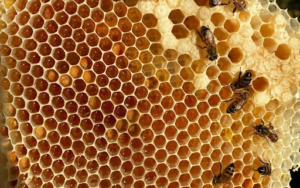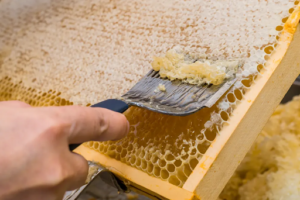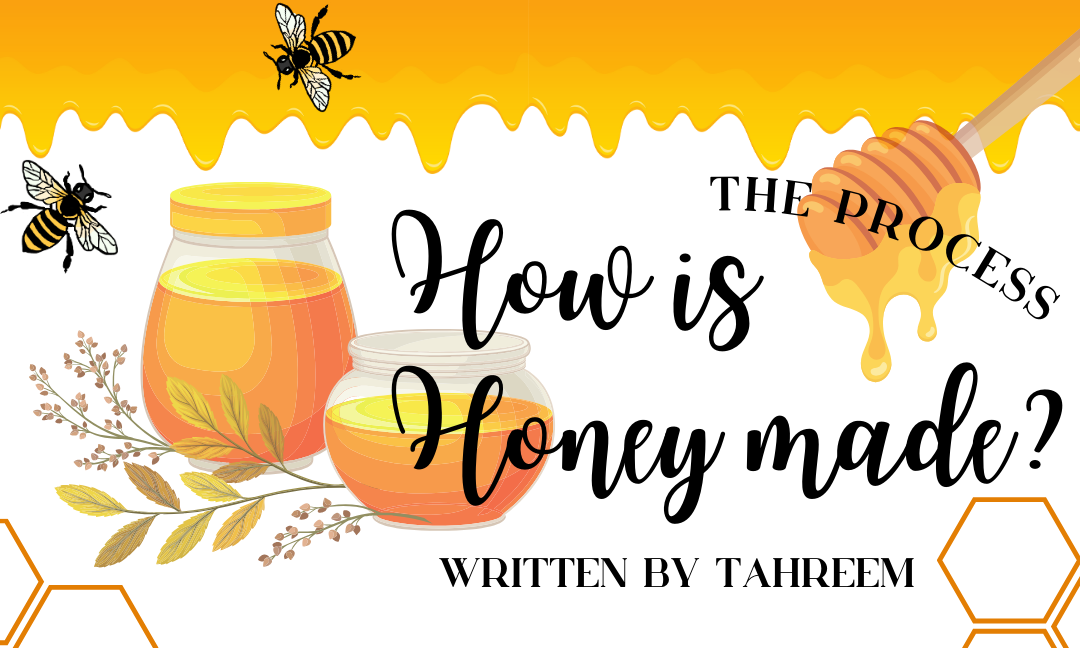Written by: Tahreem
Edited by: Nehaa Kousihan
Designed by: Ayesha
Published by: Maryam Khan
Honey has a long-lasting history and has existed for millions of years. Honey harvesting is depicted in an 8,000-year-old cave painting in Spain, and we know it’s been used for food, medicine, and other purposes by cultures all over the world since then.

But honey isn’t just about people. It’s a natural product produced by bees, one of the most significant species on our planet. In the course of their lives, honey bees visit millions of flowering, pollinating plants and gathering nectar to return to the hive.
Honey bees collect nectar to make honey and preserve it as food since it supplies energy for the bees’ flight muscles and heats the hive during the winter. Fortunately, honey bees produce more honey than the colony requires, so beekeepers must harvest and bottle the excess. They’ve been doing it since the start of time.

Honey is made when bees collect flower nectar, which is then broken down into simple sugars and stored inside the honeycomb. The honeycomb’s design and the constant fluttering of the bees’ wings cause evaporation, resulting in sweet liquid honey. The colour and flavour of honey vary depending on the nectar collected by the bees. Honey made from orange blossom nectar, for example, may be light in colour, but honey made from avocado or wildflowers may be dark amber.
Each year, a hive will produce approximately 55 pounds of surplus honey. Beekeepers collect honeycomb frames and scrape off the wax cap that bees use to seal off honey in each cell. The frames are then placed in an extractor, which is a centrifuge that spins the frames, forcing honey out of the comb.
After extracting the honey, it is strained to eliminate any leftover wax and other particles. Some beekeepers and bottlers may heat the honey to facilitate the process, but this has no effect on the liquid’s normal structure.

After straining, bottle, label, and deliver it to you. It makes no difference whether the container is glass or plastic, or whether the honey is purchased at a grocery store or a farmers’ market. If the label says “pure honey,” it means that nothing was added from bee to hive to bottle.
Most people associate honey with a liquid in a bottle, but there are many more methods to take pleasure in this natural nectar. Comb, crystallized, liquid, whipped, and beyond—it all depends on the texture and application. There is a perfect type of honey for any event among the wide range of varieties and forms available.
Honey’s colour, flavour, and even aroma differ based on the nectar of flowers visited by the bees who made it. In the entire world, there are over 300 different types of honey available, each emanating from a distinctive floral source.

Their colours range from nearly colourless to dark brown, and their flavours range from subtle to bold; even honey’s aroma may be reminiscent of the flower. In general, lighter-coloured honey has a milder flavour, while darker-coloured honey has a stronger flavour.
The process of just taking honey from the beehive and bottling it is quite simple, but the process that bees have to go through in order to produce the honey we consume takes time and effort. So, the next time you enjoy some delicious honey, remember these hardworking insects and the incredible teamwork they put forth to produce it.
Sources Cited:
Championing pure honey. National Honey Board. (n.d.). https://honey.com/about-honey/championing-pure-honey
Flow Hive US. (n.d.). How do bees make honey?. Flow Hive US. https://www.honeyflow.com/blogs/beekeeping-basics/how-do-bees-make-honey
Harvey, A. (2023, May 3). How do bees make honey? from the hive to the pot. LiveScience. https://www.livescience.com/how-do-bees-make-honey
Honey, M. (2021, February 8). The process of making honey. MAES HONEY. https://www.maeshoney.com/en/making-honey/

